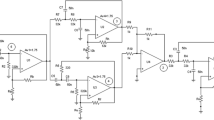Abstract
This paper presents a new fault verification method for diagnosis of parametric faults in linear analog circuits. Although there has been much research on fault verification methods there are still some open problems, such as low testability and extensive computational procedures in the case of multiple faults. The proposed method is based on the substitution theorem. It deals with the branch currents and voltages as opposed to the standard branch fault verification method, which only considers the branch current deviations. In this way, both the magnitude and phase angle of the faulty currents are taken into consideration, allowing us to check the physical meaning of the faulty currents. The fault detection procedure is based on the frequency domain measurements and the use of the sinusoidal excitation. The presented approach enhances the diagnosability, reduces on-line computations and decreases the number of required test nodes by one. The feasibility of the method is demonstrated through measurement experiments.











Similar content being viewed by others
References
Liu RW (2012) Testing and diagnosis of analog circuits and systems. Springer-Verlag New York Inc., USA
Robotycki A, Zielonko R (2002) Fault diagnosis of analog piecewise linear circuits based on homotopy. IEEE Trans Instrum Meas 51(4):876–881
Tadeusiewicz M, Halgas S (2012) Multiple soft fault diagnosis of nonlinear circuits using the continuation method. J Elect Testing: Theory Appl (JETTA) 28(4):487–493
Worsman M, Wong MWT (2000) Non-linear analog circuit fault diagnosis with large change sensitivity. Int J Circuit Theory Appl 28(3):281–303
Fedi G, Giomi R, Luchetta A, Manetti S, Piccirilli M (1998) On the application of symbolic techniques to the multiple fault location in low testability analog circuits. IEEE Trans Circuits Syst II: Analog Digital Signal Process 45(10):1383–1388
Filippetti F, Artioli M (2002) Cycling verify: fault diagnosis for linear analog circuits based on symbolic calculus and interval algebra. In: Proceedings of the 19th IEEE Instrumentation and Measurement Technology Conference, 1, pp 589–594
Tadeusiewicz M, Korzybski M (2000) A method for fault diagnosis in linear electronic circuits. Int J Circuit Theory Appl 28(3):245–262
Tadeusiewicz M, Hałgas S (2006) An algorithm for multiple fault diagnosis in analog circuits. Int J Circuit Theory Appl 34(6):607–615
Huang Z, Lin C, Liu R (1983) Node-fault diagnosis and a Design of Testability. IEEE Trans Circuits Syst 30(5):257–265
Wu Y, Tong BS (1990) The effective range of k-fault diagnosis of linear circuits. J Electron (China) 7(3):207–214
Sun Y (2008) Test and diagnosis of analogue, mixed-signal and RF integrated circuits: the system on chip approach, chapter 1. The Institute of Engineering and Technology, London, pp 1–36
Sun Y (1988) Bilinear relations for fault diagnosis of linear circuits. Proceedings of CSEE and IEE Beijing Section National Conference on CAA and CAD, Zhejiang
Yang C, Tian S, Liu Z, Huang J, Chen F (2013) Fault modeling on complex plane and tolerance handling methods for analog circuits. IEEE Trans Instrum Meas 62(10):2730–2738
Hong-zhi H, Shu-lin T, Hou-jun W, Cheng-lin Y (2013) Fault diagnosis of analog circuits based on Phasor circle model, vol 2. Proceedings of the IEEE 11th international conference on Electronic Measurement & Instruments, Harbin, pp 792–795
Zhihua L, Liuchang L (2016) Soft-fault diagnostic method based on locus circle of steady-state node-voltage vector. Int J Circuit Theory Appl 44(2):342–363
Biernacki R, Bandler J (1981) Multiple-fault location of analog circuits. IEEE Trans Circuits Syst 28(5):361–367
Lin C, Huang Z, Liu RW (1983) Topological conditions for single-branch-fault. IEEE Trans Circuits Syst 30(6):376–381
Starzyk J, Bandler J (1983) Multiport approach to multiple-fault location in analog circuits. IEEE Trans Circuits Syst 30(10):762–765
Peng M, He Y, Tan Y, Huang H, Sheng X (2003) Line fault location in a distribution network based on K-fault diagnosis method, vol 1. Proceedings of IEEE International Conference on Robotics, Intelligent Systems and Signal Processing, Hunan, pp 571–575
Huang JL, Cheng KT (2000) Test point selection for analog fault diagnosis of unpowered circuit boards. IEEE Trans Circuits Syst II: Analog Digital Signal Process 47(10):977–987
Lin CS, Liu RW (1981) Fault directory approach-a case study. In: Proceedings IEEE International Symposium on Circuits and Systems, Chicago, p 239–242
Djordjevic S (2018) Analog circuit diagnosis based on the nullor concept and multiport description of the circuit. Analog Integr Circ Sig Process 95(1):141–149
Bandler J, Salama A (1985) Fault diagnosis of analog circuits. Proc IEEE 73(8):1279–1325
Jiang BL, Wey CL, Fan LJ (1988) Fault prediction for analog circuits. J Circuits Syst Signal Process 7(1):95–109
Fedi G, Manetti S, Piccirilli M, Starzyk J (1999) Determination of an optimum set of testable components in the fault diagnosis of analog linear circuits. IEEE Transactions on Circuits and Systems I: Fundamental Theory and Applications 46(7):779–787
Author information
Authors and Affiliations
Corresponding author
Additional information
Responsible Editor: M. Margala
Publisher’s Note
Springer Nature remains neutral with regard to jurisdictional claims in published maps and institutional affiliations.
Rights and permissions
About this article
Cite this article
Djordjevic, S., Pesic, M.T. A Fault Verification Method Based on the Substitution Theorem and Voltage-Current Phase Relationship. J Electron Test 36, 617–629 (2020). https://doi.org/10.1007/s10836-020-05901-5
Received:
Accepted:
Published:
Issue Date:
DOI: https://doi.org/10.1007/s10836-020-05901-5




